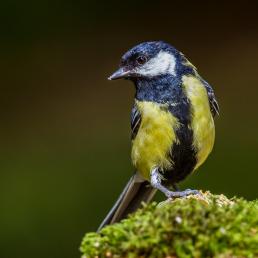

Join BirdNote tomorrow, November 30th!
Illustrator David Sibley and actor H. Jon Benjamin will face off in the bird illustration battle of the century during BirdNote's Year-end Celebration and Auction!
If this week's bright full moon pulls you outside, pause for a moment and listen. You might hear migrating songbirds overhead. Most songbirds migrate at night, when fewer predators are out. The migrants stop, feed, and rest during the day. However, many scientists believe that the main reason songbirds migrate at night is that the stars help orient them on their journey.
Tina Negus created this layered image from a combination of two images - the moon, overlaid with a flight of birds. She then adjusted the transparency and density of each layer until she obtained the desired effect. Thanks, Tina!
BirdNote®
Nocturnal Migration of Songbirds
Written by Frances Wood
This is BirdNote!
[Strains of Olivier Messiaen's Turangalila Symphony, sixth movement, "Jardin du sommeil d'amour”]
If this week’s bright full moon pulls you outside, pause for a moment and listen. You just might hear nighttime-migrating songbirds. Avid birdwatchers, particularly on the East Coast, use binoculars or telescopes to observe flocks flying across the face of the moon, a fascinating sight. The phenomenon is less easily experienced on the West Coast. Still, you may hear soft chirps floating down from the heavens.
Most migrating songbirds—including warblers, thrushes, finches, and sparrows—prefer to fly under cover of darkness. There are several possible reasons.
Fewer songbird predators are out at night, making for safer flight. The migrating birds use daylight hours to stop and feed along the way, or rest in protected spots. Evening air is cooler, more dense, making it easier for birds to generate lift. However, scientists believe that the main reason songbirds migrate at night is the stars. Birds use the stars to help orient their northward journey.
This week, wander out into the dark of evening and enjoy the bright glow of the full moon. Carefully watch the face of the moon, and imagine millions of songbirds heading north.
For BirdNote, I’m Mary McCann.
[Strains of Olivier Messiaen's Turangalila Symphony, sixth movement, "Jardin du sommeil d'amour” through to the end]
###
Music: Olivier Messiaen's Turangalila Symphony, sixth movement, "Jardin du sommeil d'amour"
Producer: John Kessler
Executive Producer: Chris Peterson
© 2014 Tune In to Nature.org April 2018/2022
ID# migration-10-2009-04-05-MM- (orig: 042105migrKPLU) migration-10





